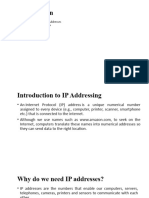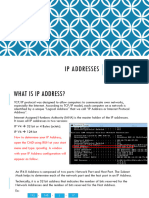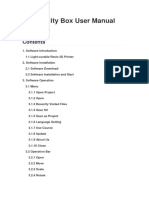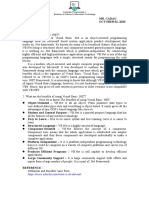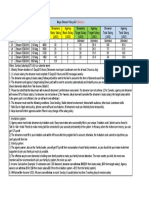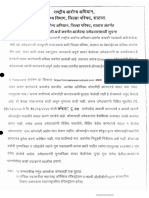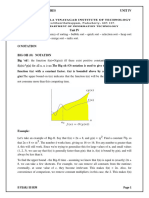Networking For DevOps
Uploaded by
Gangireddy Diwakar reddyNetworking For DevOps
Uploaded by
Gangireddy Diwakar reddyNetworking for DevOps
What is a Network?
When two or more computers and computing devices connected together with each
other through communication channels, such as cables or wireless media and sharing
some files, then it is called a Network.
A network is used to:
Allow the connected devices to communicate with each other.
Enable multiple users to share devices over the network, such as music and video
servers, printers and scanners.
The Internet is the largest network in the world and can be called "the network of
networks".
Types of Networks
There are different types of networks. But the main two are LAN and WAN
1. LAN (Local Area Network) - interconnects computer within a limited area, such as
residences, schools. e.g.: Wi-Fi, Ethernet
2. MAN (Metropolitan area network) - used in metropolitan area (cities).
3. WAN (Wide Area Network) - extends LAN over a large geographic area.
e.g:- optical fiber cable
4. SONET (Synchronous Optical Network) - used in submarine.
Network Components:
1. Switch:
It is a device which connects two or more computers.
2. Router:
It is a device which is actually used to connect one network with
another.
3. Modem:
Networking for DevOps 1
It is also a device used for modulation and Demodulation.
4. Hub:
It is just a power extension dummy device that just broadcast the
signals to its connected computers.
5. NIC:
It is known as Network Interface Card which is used to connect
your computer with the internet. It is wireless card preinstalled
on motherboard now-a-days. It has a MAC (Media Access Control)
address.
6. Bridge:
It is also a networking device that connects multiple LANs (local area
networks) together to form a larger LAN. It reduces the broadcasting
part, and it store the MAC address of the computer but now this
device is also obsoleted and replaced by switch.
What is Protocol?
A network protocol is a set of rules which is set up by people that determine how a
particular data is transmitted between different devices in the same network. e.g.:
HTTP, TCP, IP, FTP, SMTP etc.
IP Address and its Types and Classes:
IP Address: An IP (Internet Protocol) address is a unique number assigned to each
device on a network, allowing them to communicate with each other. Itʼs like a device's
"address" on the internet or local network.
Types of IP Addresses
1. IPv4:
32-bit address, written as four numbers separated by dots (e.g.,
123.89.46.7 ).
Networking for DevOps 2
This is a 32-bit IP address, means it contains a combo of 32 (1 and 0's). In this
version of IP address there are 4 groups or Octets (8 bits), and each octet is
represented by a decimal value in the address. It is easy to remember.
Commonly used, but limited number of addresses (about 4.3 billion).
2. IPv6:
128-bit address, written in eight groups of hexadecimal numbers (e.g.,
2001:0db8:85a3:0000:0000:8a2e:0370:7334 ).
Provides a vastly larger pool of addresses, designed to replace IPv4 as it runs out.
3. Public IP:
Used to identify devices on the internet.
Assigned by ISPs and accessible globally.
4. Private IP:
Used within private networks (like home or office networks).
Not accessible from the internet; usually in ranges like 192.168.x.x ,
Networking for DevOps 3
10.x.x.x , or 172.16.x.x - 172.31.x.x .
5. Static IP:
Manually assigned, doesnʼt change.
Often used for servers and devices that need a consistent address.
6. Dynamic IP:
Automatically assigned by a DHCP (Dynamic Host Configuration Protocol) server.
Changes periodically; commonly used for home devices.
IP Address Classes (IPv4 Only)
There is an organization called IANA (Internet Assigned Numbers Authority) who divides
the IP address into different classes. You have to know about binary to decimal conversion
to understand this.
IPv4 addresses are divided into five classes based on the starting number, which
determines their usage in networks.
Class Range Purpose
A 1.0.0.0 - 126.0.0.0 Large networks, like big organizations.
B 128.0.0.0 - 191.255.0.0 Medium-sized networks.
C 192.0.0.0 - 223.255.255.0 Small networks, like home or business LANs.
224.0.0.0 -
D 239.255.255.255 Reserved for multicasting.
240.0.0.0 -
E 255.255.255.255 Experimental, used for research.
Networking for DevOps 4
Note:
Class A addresses in IPv4 officially start from 1.0.0.0 and go up to 126.0.0.0.
The address 0.0.0.0 is not part of the Class A range and has a special purpose
in networking.
0.0.0.0 is a special address, not part of the usable IP address range in Class A.
The 127.0.0.0 to 127.255.255.255 range, especially 127.0.0.1, is reserved for
loopback addresses in IPv4.
What is Loopback?
Loopback address allows a device to communicate with itself.
Itʼs often used for testing network software on the local machine.
Networking for DevOps 5
Key Points:
127.0.0.1 is commonly known as "localhost."
Any IP address in the 127.x.x.x range will loop back to the same device.
Useful for testing networking applications without needing an external network.
IP address - Network ID and Host ID:
There are two parts to an IP address - Network ID and Host ID (Any device which gets
the IP address is called a Host).
The Network ID portion differs depending on the IP class:
Class A: 1st octet is the Network ID.
Class B: 1st and 2nd octets are the Network ID.
Class C: 1st, 2nd, and 3rd octets are the Network ID.
Direct Connection: Devices with the same Network ID can connect without a router.
Router Requirement: Devices with different Network IDs need a router to connect.
We will try to break it with text based structural diagram for a better understanding:
+---------------------+---------------------+-----------------
| Class C | 1st, 2nd & 3rd | 4th Octet
| | Example: 192.168.1.1| (1)
+---------------------+---------------------+-----------------
Device Connection Scenario:
Networking for DevOps 6
1. Device A IP Address: 17.0.0.1 (Class A)
2. Device B IP Address: 17.0.4.2 (Class A)
Network ID for Class A: 17 (1st Octet)
Since both devices have the same Network ID (17), they
are in the same network and can connect directly.
Connection Summary:
+-----------------------+---------------------------+---------
| Device A IP | Device B IP | Connec
+-----------------------+---------------------------+---------
| 17.0.0.1 | 17.0.4.2 | Direct
+-----------------------+---------------------------+---------
| 17.0.0.1 | 192.168.1.5 | Requir
+-----------------------+---------------------------+---------
Explanation:
- If Device A and Device B are in the same network (same Netwo
- If they are on different networks (different Network IDs), a
Router Usage:
+-----------------------+---------------------------+---------
| Different Networks | Example: | Connec
+-----------------------+---------------------------+---------
| Device A Network ID | 17 (Class A) |
| Device B Network ID | 192.168 (Class C) |
| Router Needed | Yes | Requir
+-----------------------+---------------------------+---------
Subnetting:
Divides a network into smaller, more manageable segments.
Example: A network with IP address 192.168.1.0/24 can be divided into subnets like
192.168.1.0/25 and 192.168.1.128/25.
Networking for DevOps 7
Example of Subnetting:
Given network: 192.168.1.0/24
192.168.1.0/24 is a Class C network.
/24 indicates a subnet mask of 255.255.255.0, meaning there are 8 bits for
hosts (32 total bits in IPv4 - 24 bits for the network portion 8 bits for hosts).
192.168.1.0/24 provides 256 IP addresses (from 192.168.1.0 to 192.168.1.255).
Dividing into Smaller Subnets:
To divide this into two equal subnets, we can use /25 subnet masks, which allocate 7
bits for hosts (32 - 25 7 bits for hosts).
1. Subnet 1: 192.168.1.0/25
Range: 192.168.1.0 to 192.168.1.127
Subnet Mask: 255.255.255.128
Total IPs: 128 addresses (126 usable for hosts, as the first address is the network
address and the last is the broadcast address).
2. Subnet 2: 192.168.1.128/25
Range: 192.168.1.128 to 192.168.1.255
Subnet Mask: 255.255.255.128
Total IPs: 128 addresses (126 usable for hosts).
Summary Table
Subnet Range Subnet Mask Total IPs Usable Host IPs
192.168.1.0 -
192.168.1.0/25 192.168.1.127 255.255.255.128 128 126
192.168.1.128 -
192.168.1.128/25 192.168.1.255 255.255.255.128 128 126
Explanation:
By using a /25 mask instead of /24, we split the network into two subnets with 128
IP addresses each.
This creates smaller segments within the original network, making it easier to manage
specific groups of hosts separately.
Networking for DevOps 8
Benefits of Subnetting:
1. Improves Network Performance: Reduces broadcast domains, limiting broadcast
traffic to specific subnets.
2. Enhances Security: Allows segregation of different departments or functions within
an organization.
3. Efficient IP Usage: Prevents wasting IP addresses by only allocating what is
necessary for each subnet.
CIDR (Classless Inter-Domain Routing):
CIDR (Classless Inter-Domain Routing) is a method for allocating IP addresses
and IP routing that replaces the older classful network system. It was introduced to
improve IP address utilization and simplify routing.
The table below outlines the most common combination of addresses and
netmasks and important details about them.
Number of Relation to
Prefix Netmask addresses class Comment
1 Single host in a
/32 255.255.255.255 Class C/256 network
/25 255.255.255.128 128 Class C/2
/24 255.255.255.0 256 Class C
/23 255.255.254.0 512 Class C*2
Class C*256
/16 255.255.0.0 65,536 Class B
/15 255.254.0.0 131,072 Class B*2
Class B*256
/8 255.0.0.0 16,777,216 Class A
0.0.0.0/0 means
entire internet.
/0 0.0.0.0 4,294,967,296 Class A*256 Often used in
public firewall
rules
Network Models
Networking for DevOps 9
There are mainly two types of network model -
1. OSI Reference Model
2. TCP/IP Model
1. OSI Reference Model:
The OSI (Open Systems Interconnection) Model is a set of rules that explains how
different computer systems communicate over a network. OSI Model was developed by
the International Organization for Standardization (ISO). The OSI Model consists
of 7 layers and each layer has specific functions and responsibilities.
1. Physical Layer: Handles the physical connection between devices, transmitting raw
data as bits over cables, radio signals, etc.
2. Data Link Layer: Manages data transfer between directly connected nodes.
It handles error detection and flow control. Examples: Ethernet, Wi-Fi.
3. Network Layer: Manages packet forwarding and routing through the network. Uses
IP addressing. Example: IP (Internet Protocol).
4. Transport Layer: Ensures reliable data transfer with error correction and flow
control. Examples: TCP, UDP.
5. Session Layer: Establishes, maintains, and manages communication sessions
between applications.
6. Presentation Layer: Translates data formats to ensure compatibility between
systems. Handles encryption and compression. Example: SSL/TLS.
7. Application Layer: Interfaces directly with the user and provides network services
like HTTP, FTP, SMTP.
Hereʼs a
text-based structural diagram that shows the flow through the OSI model from
Person X to Person Y:
Networking for DevOps 10
Networking for DevOps 11
Networking for DevOps 12
The infographic below summarizes the seven layers of the OSI reference
model.
Networking for DevOps 13
Networking for DevOps 14
Below is the list of protocols in each layer of the OSI model along with their port
numbers (where applicable):
1. Application Layer (Layer 7)
HTTP (Port 80): Web browsing.
HTTPS (Port 443): Secure web browsing.
SMTP (Port 25): Sending email.
FTP (Ports 20, 21): File transfer.
DNS (Port 53): Domain name resolution.
POP3 (Port 110): Receiving email.
IMAP (Port 143): Receiving email.
2. Presentation Layer (Layer 6)
SSL/TLS (Port 443 for HTTPS, also used in other protocols): Encryption for secure
data transmission.
MIME: Used for formatting email attachments.
JPEG/PNG: Image formats used to encode multimedia files.
3. Session Layer (Layer 5)
PPTP (Port 1723): Tunneling protocol for VPNs.
NetBIOS (Ports 137, 138, 139): Establishes sessions for network communications.
4. Transport Layer (Layer 4)
TCP: Reliable data transmission with acknowledgment.
UDP: Fast, connectionless data transmission without acknowledgment.
SCTP: Used for applications that require multiple data streams.
5. Network Layer (Layer 3)
IP (IPv4/IPv6): Routing packets between source and destination.
ICMP: Error messaging and diagnostics (e.g., ping).
IGRP: Routing protocol used for sharing routing information.
Networking for DevOps 15
6. Data Link Layer (Layer 2)
Ethernet: Defines physical addressing and channel access.
PPP: Used for point-to-point connections.
HDLC: For framing and error control on point-to-point links.
ARP: Resolves IP addresses to MAC addresses.
7. Physical Layer (Layer 1)
Ethernet (Physical signaling): Specifies electrical signals, cabling, etc.
USB: Used to physically connect devices.
Summary with Ports
Application Layer (Layer 7) contains the most recognizable protocols with specific
port numbers for communication (e.g., HTTP - Port 80, HTTPS - Port 443,
SMTP - Port 25).
Layers 2 to 6 typically deal with specific network management functions and do not
use port numbers as these layers are responsible for connections and managing data
formats.
Port numbers are used primarily in the Application and Transport Layers to ensure
data is delivered to the correct services and applications running on a computer.
2. TCP/IP Model:
The
TCP/IP model, also known as the Internet Protocol Suite, is a simplified version of
the OSI model with only 4 layers instead of 7.
This model is a real model which actually works in real. This model consists of 4 layers.
1. Application Layer = (Application Layer + Presentation Layer + Session Layer) of OSI
model
2. Transport Layer
3. Network Layer
4. Network Interface Layer = (Data Link Layer + Physical Layer) of OSI
Networking for DevOps 16
model (remaining all are same like OSI model discussed above.)
Networking for DevOps 17
Ports and Protocols:
1. HTTP (Hypertext Transfer Protocol):
It is a client server stateless (means it never stores any data of client) protocol, and it
tells us how it requests any data from the server and also tells us how the server will
send the data back to the client.
- When a client makes a request - HTTP request
- When server sends response to client - HTTP response -- Some HTTP methods used
to make any request
Status codes are issued by a server in response to a client's request made to the server.
There are 4 categories of HTTP responses:
1. 200s: Successful responses
2. 300s: Redirects
3. 400s: Client errors
4. 500s: Server errors
Take a look at some of the most common response codes:
Code What Itʼs Telling What it Means
200 OK Request succeeded.
Found, Temporary The URI of the requested resource has been changed
302, 307 Redirect temporarily.
Moved The URI of the requested resource has been changed
Permanently, permanently.
301, 308
Permanent Redirect
The server canʼt understand the request being sent.
400 Bad Request
Networking for DevOps 18
The client must authenticate itself before sending the
401 Unauthorized request.
The client does not have enough permission to access
403 Forbidden the content.
404 Not Found The server canʼt find the requested resource.
The response was sent to an idle connection, and the
408 Request Timeout server wants to terminate it.
Internal Server The server does not know how to handle a request.
500 Error
The server you are trying to access is a gateway or a
reverse proxy (it sits between the client and an actual
502 Bad Gateway server that serves the page). You get this error when
the gateway gets an incorrect response from a source
server.
Service The server canʼt process the request. This usually
503 Unavailable happens when a server is down or overloaded.
Similar to 502, the gateway canʼt get a response in
504 Gateway timeout time.
Find the complete list of status codes with detailed explanations by Mr.
Abhishek Veeramalla (Thank you!):
iam-veeramalla/http-status-codes: Repo to demonstrate HTTP status codes
I have said that HTTP is a stateless protocol, means it never store any data of
client in server. Then suppose when you will search for the second time amazon.com then
it should be logged out from the server, and you have to log in again for second time
visit, but you don't. In second time, it's automatically logged in, and you can see all of
your saved carts 🛒 and all data. So how it is possible?? Here, cookies come into the
picture.
Networking for DevOps 19
Cookies is a unique string stored as a file in your browser and when
you search for the second time the website you visited previously,
cookies which saved in your browser will send the details through
HTTP to the server and server will check it and automatically logged
you in.
2. SMTP/POP (Simple Mail Transfer Protocol and Post Office Protocol):
SMTP is used in sending and receiving any email from senders SMTP server to
Receiver's SMTP server
POP is used to download any email from POP server
3. FTP (File Transfer Protocol):
FTP is used to download, upload and transfer files from one host to another host.
4. Secure shell (SSH):
Similar to Telnet. Itʼs used by system administrators to securely access to access a
computer over an insecure network.
5. TCP (Transmission Control Protocol):
Reliable and connection-oriented protocol.
Ensures data is delivered successfully with acknowledgements and
retransmission if needed.
Used for applications where data integrity is crucial.
Example: HTTP (port 80), SQL (port 1433).
TCP and the Three-Way Handshake:
Networking for DevOps 20
Before transmitting packets, TCP must ensure that a stable connection has been
set up between the sender and the recipient. This is where the three- way
handshake (or SYN-SYN-ACK) comes in.
6. UDP (User Datagram Protocol):
Unreliable and connectionless protocol.
No acknowledgements, no retransmission; faster but no guarantee of delivery.
Used for applications needing speed over reliability.
Example: Video Streaming or DNS queries.
Find the link below for Common Ports and Protocols Cheat Sheet (Thanks to
Stationx):
Common Ports Cheat Sheet: The Ultimate List
Routing:
So how do we get a packet of information from a host on one network to a host in
another? In one word: Routing.
We use tables to help us determine the routes we want to take. This screenshot
demonstrates a typical route table in AWS:
Networking for DevOps 21
When making a routing decision, more narrow rules are evaluated first:
If a packet destination is in a range of 10.21.0.0/16 – it will remain in a local network
(your neighborhood).
If a packet destination is in a range of 10.0.0.0/8 – it will be sent to the transit gateway
(TGW) interface (your state highways).
If a packet destination does not fall in any of these ranges, the widest one is evaluated
which is 0.0.0.0/0 which means it is internet traffic. And the packet will be redirected
to the Network Address Translation (NAT) interface.
DNS (Domain Name System):
DNS (Domain Name System) translates human-readable domain names (e.g.,
www.example.com) into IP addresses (for example, 192.0.2.44).
Root DNS Server stores all the Top-level domain e.g : - .com, .in, .org, .io etc.
DNS works like the phonebook of the internet, allowing humans to use readable names
while machines use numerical addresses.
How DNS Works
When you type a website address (e.g., www.example.com ) into your browser, it needs
to know the IP address of that server.
The DNS process involves looking up the domain name and finding the corresponding
IP address through multiple DNS servers.
Example: Visiting a Website
1. User Request:
You type www.example.com into your web browser.
2. DNS Query:
Networking for DevOps 22
Your browser sends a request to a DNS server to get the IP address of
www.example.com .
3. DNS Resolution:
The DNS server checks if it has the IP address cached. If not, it contacts other
DNS servers (root, TLD, and authoritative servers) to find the IP address.
4. IP Address Found:
Once the IP address (e.g., 93.184.216.34) is found, the DNS server sends it back
to your browser.
5. Connecting to the Website:
The browser uses this IP address to connect to the web server, and the website
loads on your screen.
Domains, Zones, and Delegation:
1. Domains: Domains are like branches in a tree-like structure of the internet. The
root domain is the highest level, followed by top-level domains (TLDs) like .com
, .org , etc. Subdomains (e.g., example.com ) branch off from TLDs.
2. Zones: A zone is a portion of the domain that is managed by a specific
organization. For instance, .com is a zone controlled by Verisign. ICANN manages
the root zone at the top of the DNS tree, while different organizations manage
subdomains.
3. Delegation: Delegation allows one organization to hand over control of part of
its domain to another organization. This is done using Nameserver (NS) records.
For example, ICANN controls the root domain and delegates .com to Verisign.
Verisign can then delegate control over example.com to "Example Ltd" by adding an
NS record those points to their nameserver.
The NS records direct traffic to the appropriate nameserver that manages a domain,
allowing different parts of the DNS tree to be managed independently by different
organizations.
Networking for DevOps 23
DNS record types:
DNS records, also known as zone files, provide information about a domain. This includes
the IP address that is associated with this domain and how to handle queries for it. Each
DNS record has a time-to-live setting (TTL) which indicates how often a DNS server will
refresh it.
Below are the most commonly used types of DNS records and their meaning:
Type Name Description
The most basic and the most commonly used DNS
A Host address record. It translates human-friendly domain names
into computer-friendly IP addresses.
Same as A but for IPv6 (a host address that can have
AAAA IPv6 host address more than one IP address).
Maps a name to another name. It should only be used
CNAME Canonical name for when there are no other records on that name.
an alias
Maps a name to another name but can coexist with
ALIAS Auto resolved alias other records on that name.
Specifies the e-mail server(s) responsible for a domain
MX Mail eXchange name.
Identifies the DNS servers responsible for a zone.
NS Name Server One NS record for each DNS server in a zone.
TXT Descriptive Text Holds general information about a domain name such
as who is hosting it, contact person, phone
Networking for DevOps 24
numbers, etc. Widely used for domain ownership
verification.
DHCP
DHCP (Dynamic Host Configuration Protocol) is a network management
protocol that automatically assigns IP addresses and other network
configurations (such as subnet mask, gateway, DNS servers) to devices on a
network.
Example:
When you connect your laptop to a Wi-Fi network, a DHCP server assigns it an IP
address automatically, allowing it to communicate with other devices on the
network without manual configuration.
Network Components and Services
Routers and Switches
Routers: Connect different networks and direct data packets between them.
Switches: Connect devices within the same network and use MAC addresses to
forward data to the correct device.
Firewalls
Firewalls control incoming and outgoing network traffic based on predetermined security
rules.
Load Balancers
Load balancers distribute incoming network traffic across multiple servers to ensure no
single server becomes overwhelmed.
VPN
VPN (Virtual Private Network) provides a secure connection between remote users and
the corporate network over the internet.
Networking for DevOps 25
Network Troubleshooting Tools:
1. ping
Purpose: Test internet network connections.
How It Works: Uses the ICMP ECHO_REQUEST to get an ICMP
ECHO_RESPONSE from a remote host.
Usage: For basic troubleshooting, you can run ping www.google.com to check network
connectivity and see response times and packet loss.
2. traceroute (or tracert on Windows)
Purpose: Track the route packets take to reach their destination.
How It Works: Sends UDP probes with increasing TTL values, showing each router
along the route and the delay in reaching it.
Usage: Helps find which gateway is causing a delay by showing response times and
where packets fail (indicated by ).
3. telnet
Purpose: Test network connections and protocols.
How It Works: Attempts to establish a connection to a specified IP and port.
Usage: Test if a specific service is reachable, e.g., telnet google.com 443 .
4. curl
Purpose: Transfer data using multiple protocols, often for HTTP requests.
Usage:
Basic GET request: curl http://example.com .
Check headers: curl -I http://example.com .
POST request: curl -X POST http://example.com .
Save response to file: curl http://example.com/file -o output.file .
5. dig (Domain Information Groper)
Purpose: Troubleshoot DNS problems and verify DNS records.
Networking for DevOps 26
How It Works: Performs DNS lookups and displays information such as IP addresses.
Usage: dig google.com to get information like IP addresses, TTL, and DNS record types.
6. netstat
Purpose: Show network connections and port listening information.
Usage:
netstat -lp : List listening servers and their program names. netstat -a :
Show all active ports.
netstat -r : Show routing table.
7. nmap (Network Mapper)
Purpose: Discover hosts and services on a network.
How It Works: Sends raw packets to identify hosts, services, and operating systems.
Usage:
Discover hosts: nmap -sn 172.31.44.35/20 .
Scan ports on a host: nmap -A 172.31.36.237 .
8. ssh (Secure Socket Shell)
Purpose: Securely connect to remote machines to execute commands.
Usage:
Connect to a server: ssh username@hostname .
Secure and encrypted, used for remote management and file transfers.
9. scp (Secure Copy Protocol)
Purpose: Securely copy files between local and remote hosts.
Usage:
Copy file to a remote server: scp localfile.txt user@remote:/path/to/destination .
These tools are invaluable for network diagnostics, troubleshooting, and secure
communications, which are critical skills for any DevOps engineer.
Networking for DevOps 27
You might also like
- Networking For DevOps - The Backbone of AutomationNo ratings yetNetworking For DevOps - The Backbone of Automation27 pages
- 2q Lesson 2.1 12 Css Midterm - Ip AddressingNo ratings yet2q Lesson 2.1 12 Css Midterm - Ip Addressing47 pages
- Lecture 05-Data Communication & Network IP AddressingNo ratings yetLecture 05-Data Communication & Network IP Addressing19 pages
- Private Ip Addresses: Ethernet Ethernet Is The Most Used Networking Technology For Lans Today. It Defines Wiring andNo ratings yetPrivate Ip Addresses: Ethernet Ethernet Is The Most Used Networking Technology For Lans Today. It Defines Wiring and48 pages
- Qa Session 5 - Basic of Computer NetworkingNo ratings yetQa Session 5 - Basic of Computer Networking6 pages
- 1 Internet Protocol Managing Networks ReviewNo ratings yet1 Internet Protocol Managing Networks Review46 pages
- IP Protocol Part 3 IP Classes Network Host IDsNo ratings yetIP Protocol Part 3 IP Classes Network Host IDs9 pages
- Addressing: The What' and Where' of CommunicationNo ratings yetAddressing: The What' and Where' of Communication58 pages
- Series PM135 Powermeters PM135P/PM135E/PM135EH: Modbus Communications ProtocolNo ratings yetSeries PM135 Powermeters PM135P/PM135E/PM135EH: Modbus Communications Protocol77 pages
- SI Analytics Lab 845 - Catalogue Pages 1 6No ratings yetSI Analytics Lab 845 - Catalogue Pages 1 66 pages
- ISO 9000:2005 - QMS - Fundamentals and Vocabulary67% (3)ISO 9000:2005 - QMS - Fundamentals and Vocabulary34 pages
- Computer Programming 1 Bachelor of Science in Information TechnologyNo ratings yetComputer Programming 1 Bachelor of Science in Information Technology1 page
- 500+ Nature-Inspired Metaheuristics AnalysisNo ratings yet500+ Nature-Inspired Metaheuristics Analysis25 pages
- MESA Collaborative Manufacturing Dictionary 2 EditionNo ratings yetMESA Collaborative Manufacturing Dictionary 2 Edition60 pages
- Differences Between Quality Assurance and Quality Control - GeeksforGeeksNo ratings yetDifferences Between Quality Assurance and Quality Control - GeeksforGeeks6 pages
- Atmega809/1609/3209/4809 - 48-Pin: 48-Pin Data Sheet - Megaavr® 0-SeriesNo ratings yetAtmega809/1609/3209/4809 - 48-Pin: 48-Pin Data Sheet - Megaavr® 0-Series82 pages
- Fact - Sheet - Spectra-Professional - 2 2No ratings yetFact - Sheet - Spectra-Professional - 2 21 page
- List of 1SFB To1SFA Codes For Spare Parts - 20200925No ratings yetList of 1SFB To1SFA Codes For Spare Parts - 2020092518 pages

























